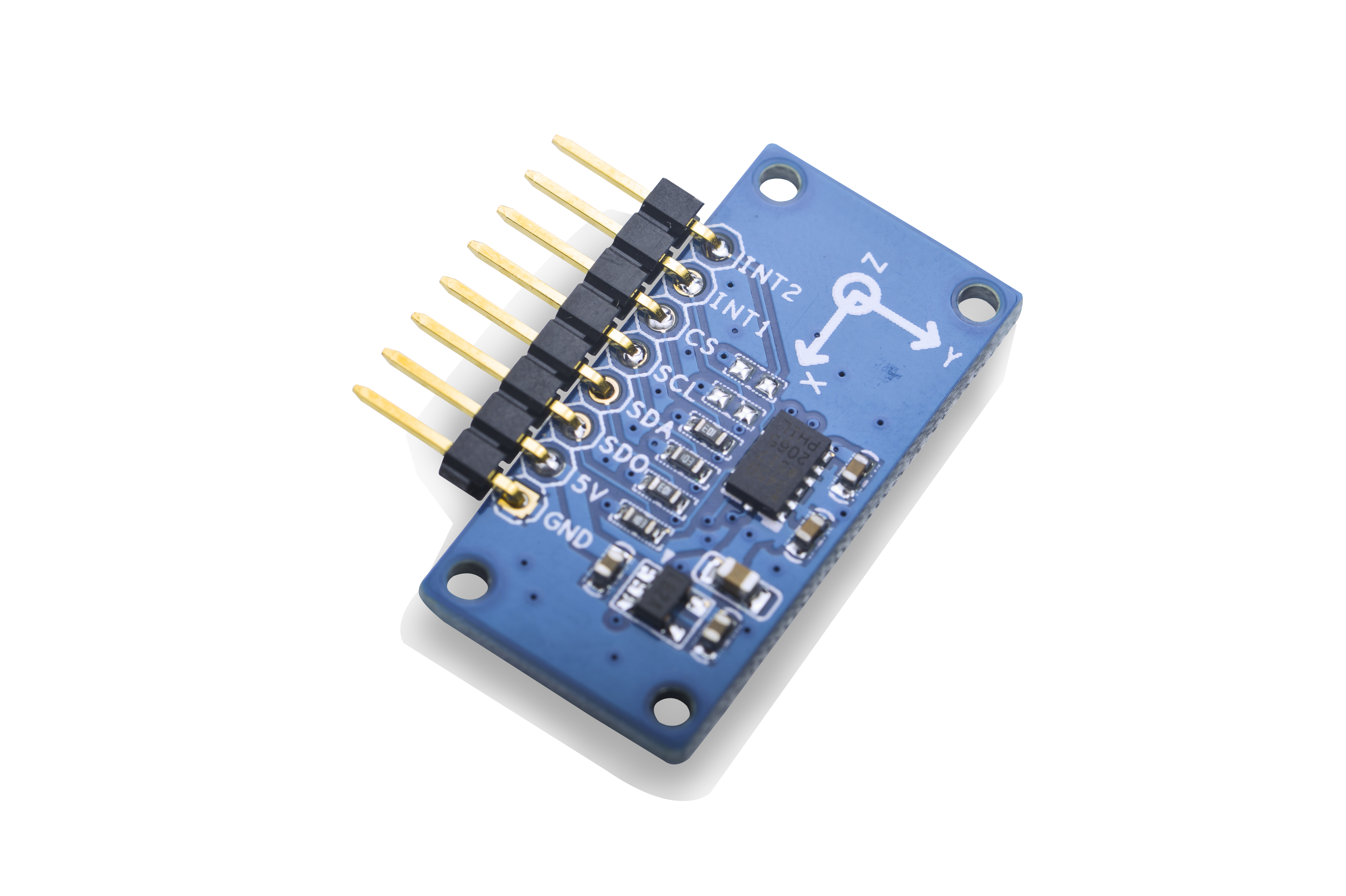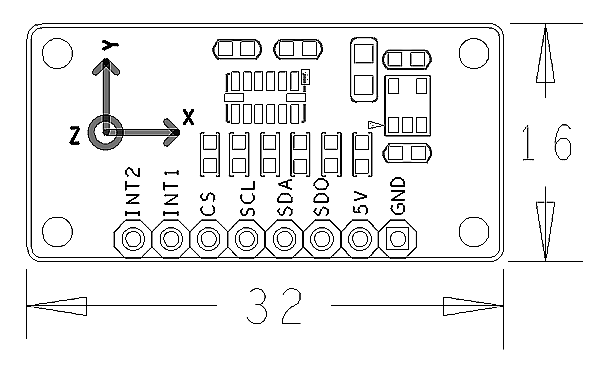Difference between revisions of "Matrix - 3-Axis Digital Accelerometer"
(→Features) |
|||
| Line 1: | Line 1: | ||
| − | [[Matrix - 3-Axis Digital Accelerometer | + | [[Matrix - 3-Axis Digital Accelerometer|English]] |
| − | == | + | ==介绍== |
[[File:3AD.png|thumb|3-Axis Digital Accelerometer]] | [[File:3AD.png|thumb|3-Axis Digital Accelerometer]] | ||
| − | * | + | * 模块Matrix-3_Axis_Digital_Accelerometer用于测量x\y\z方向上的加速度,进而计算速度。 |
| − | * | + | * 搭载了一颗ADXL345芯片,可以使用IIC或SPI进行通信。 |
| − | * | + | * 13-bit精度,采集范围可以是+-2g,+-4g,+-8g和+-16g,既能测定动态加速度,也能测定静态加速度。 |
| − | * | + | * 采用5V供电,PCB上的电源转换芯片输出3.3V给ADXL345。 |
| − | == | + | ==特性== |
| − | * | + | * I2C接口,3.3V |
| − | * 13- | + | * 13-bit,up to +-16g |
| − | * 2. | + | * 2.54mm排针接口,接线方便,通用性强 |
| − | * | + | * +-16g,13-bit精度 |
| + | * PCB尺寸(mm):16x32 | ||
[[File:adxpcb.png|frameless|400px|重力加速度PCB]] | [[File:adxpcb.png|frameless|400px|重力加速度PCB]] | ||
| − | * | + | * 引脚说明:<br> |
{| class="wikitable" | {| class="wikitable" | ||
|- | |- | ||
| − | | | + | |名称 || 描述 |
|- | |- | ||
| − | |INT2 || | + | |INT2 || 中断引脚 |
|- | |- | ||
| − | |INT1 || | + | |INT1 || 中断引脚 |
|- | |- | ||
| − | |CS | + | |CS || 使能引脚 |
|- | |- | ||
|SCL || I2C SCL | |SCL || I2C SCL | ||
| Line 30: | Line 31: | ||
|SDA || I2C SDA | |SDA || I2C SDA | ||
|- | |- | ||
| − | |SDO | + | |SDO || 设置slave address |
|- | |- | ||
| − | |5V | + | |5V || 电源5V |
|- | |- | ||
| − | |GND || | + | |GND || 地 |
|} | |} | ||
| − | == | + | ==工作原理== |
| − | * | + | * ADXL345 是一款小巧纤薄的低功耗三轴加速度计,可以对高达±16 g的加速度进行高分辨率(13 位)测量。数字输出数据为 16 位二进制补码格式,可通过SPI (3 线或 4 线)或者I2C数字接口访问。 |
| − | * | + | * ADXL345 非常适合移动设备应用。它可以在倾斜检测应用中测量静态重力加速度,还可以测量运动或冲击导致的动态加速度。它具有高分辨率(4 mg/LSB),能够测量约 0.25°的倾角变化。 |
| − | * | + | * 由于这里使用的是I2C通信方式,所以只简单的介绍I2C的工作原理,具体时序的实现可自行去查看芯片手册。ADXL345遵循 Philips I2C-总线协议,它支持标准的数据传输模式(100KHz),并且支持快速传输模式(400KHz),采用I2C模式,需要把CS引脚上拉,I2C引脚无连接时,默认模式不存在。 |
| − | * | + | * 这里采用I2C通信,接线方式如下图: |
[[File:三轴重力.png|frameless|400px|三轴重力加速度]] | [[File:三轴重力.png|frameless|400px|三轴重力加速度]] | ||
| − | == | + | ==下载Matrix源码== |
| − | + | Matrix配件相关的代码是完全开源的,统一由一个仓库进行管理:git://github.com/friendlyarm/matrix.git <br> | |
| − | + | 该仓库里不同的分支代表着Matrix配件所支持的不同开发板。<br> | |
| − | * | + | * nanopi分支用于支持NanoPi; |
| − | * | + | * nanopi2分支用于支持NanoPi 2; |
| − | * | + | * tiny4412分支用于支持Tiny4412; |
| + | * raspberrypi分支用于支持RaspberryPi; | ||
| − | + | 在主机PC上安装git,以Ubuntu14.04为例: | |
| − | + | ||
<syntaxhighlight lang="bash"> | <syntaxhighlight lang="bash"> | ||
$ sudo apt-get install git | $ sudo apt-get install git | ||
</syntaxhighlight> | </syntaxhighlight> | ||
| − | + | 克隆Matrix配件代码仓库: | |
<syntaxhighlight lang="bash"> | <syntaxhighlight lang="bash"> | ||
$ git clone git://github.com/friendlyarm/matrix.git | $ git clone git://github.com/friendlyarm/matrix.git | ||
</syntaxhighlight> | </syntaxhighlight> | ||
| − | + | 克隆完成后会得到一个名为matrix的目录,里面存放着所有Matrix配件的代码。 | |
| − | == | + | ==与NanoPi 2连接使用== |
| − | === | + | ===准备工作=== |
| − | + | 在NanoPi 2上运行Debian系统,然后在主机PC上安装并使用相应的编译器,参考wiki: [[NanoPi_2/zh|NanoPi_2]] & [[How_to_build_the_Compiling_Environment/zh|How to Build the Compiling Environment]]。<br> | |
| + | 注意: 只有使用s5p4418-nanopi2-matrix分支编译出来的内核才能配合Matrix配件正常工作。<br> | ||
| + | 下载NanoPi 2内核源代码并编译:<br> | ||
| + | <syntaxhighlight lang="bash"> | ||
| + | $ git clone https://github.com/friendlyarm/linux-3.4.y.git | ||
| + | $ cd linux-3.4.y | ||
| + | $ git checkout s5p4418-nanopi2-matrix | ||
| + | $ make nanopi2_linux_defconfig | ||
| + | $ touch .scmversion | ||
| + | $ make | ||
| + | </syntaxhighlight> | ||
| + | 编译好后的uImage位于内核源码arch/arm/boot/目录下,把该uImage替换掉SD卡boot分区上的uImage即可。<br> | ||
| − | === | + | ===硬件连接=== |
| − | + | 参考下图连接模块Matrix-3_Axis_Digital_Accelerometer和NanoPi 2:<br> | |
| − | [[File: | + | [[File:Matrix-3_Axis_Digital_Accelerometer_nanopi_2.jpg|frameless|600px|Matrix-3_Axis_Digital_Accelerometer_nanopi_2]] |
| − | + | 连接说明: | |
{| class="wikitable" | {| class="wikitable" | ||
|- | |- | ||
| − | |Matrix-3_Axis_Digital_Accelerometer || NanoPi | + | |Matrix-3_Axis_Digital_Accelerometer || NanoPi 2 |
|- | |- | ||
| − | |INT2 || | + | |INT2 || 留空 |
|- | |- | ||
| − | |INT1 || | + | |INT1 || 留空 |
|- | |- | ||
| − | |CS | + | |CS || Pin1 |
|- | |- | ||
|SCL || Pin5 | |SCL || Pin5 | ||
| Line 86: | Line 98: | ||
|SDA || Pin3 | |SDA || Pin3 | ||
|- | |- | ||
| − | |SDO | + | |SDO || Pin2 |
|- | |- | ||
| − | |5V | + | |5V || Pin4 |
|- | |- | ||
|GND || Pin6 | |GND || Pin6 | ||
|} | |} | ||
| − | === | + | ===编译测试程序=== |
| − | + | 进入Matrix代码仓库,切换到nanopi2分支 | |
<syntaxhighlight lang="bash"> | <syntaxhighlight lang="bash"> | ||
$ cd matrix | $ cd matrix | ||
| − | $ git checkout | + | $ git checkout nanopi2 |
</syntaxhighlight> | </syntaxhighlight> | ||
| − | + | 编译Matrix配件代码 | |
<syntaxhighlight lang="bash"> | <syntaxhighlight lang="bash"> | ||
$ make CROSS_COMPILE=arm-linux- clean | $ make CROSS_COMPILE=arm-linux- clean | ||
| Line 106: | Line 118: | ||
$ make CROSS_COMPILE=arm-linux- install | $ make CROSS_COMPILE=arm-linux- install | ||
</syntaxhighlight> | </syntaxhighlight> | ||
| − | + | 注意:请确保你的主机PC当前使用的交叉编译器为NanoPi 2配套的arm-linux-gcc.4.8.5。<br> | |
| − | + | 编译成功后库文件位于install/lib目录下,而测试程序则位于install/usr/bin目录下,模块Matrix-3_Axis_Digital_Accelerometer对应的测试程序为matrix-accelerometer。<br> | |
| − | === | + | ===运行测试程序=== |
| − | + | 将带有Debian系统的SD卡插入一台运行Linux的电脑,可以挂载SD卡上的boot和rootfs分区。<br> | |
| + | 假设rootfs分区的挂载路径为/media/rootfs,执行以下命令可将Matrix的所有库文件和测试程序拷贝到NanoPi 2的文件系统上。<br> | ||
<syntaxhighlight lang="bash"> | <syntaxhighlight lang="bash"> | ||
| − | $ cp install/usr/bin/* | + | $ cp install/usr/bin/* /media/rootfs/usr/bin/ |
| − | $ cp install/lib/* | + | $ cp install/lib/* /media/rootfs/lib/ -d |
</syntaxhighlight> | </syntaxhighlight> | ||
| − | + | 将SD卡重新插入NanoPi 2,上电启动,在Debian的shell终端中执行以下命令运行模块Matrix-3_Axis_Digital_Accelerometer的测试程序。<br> | |
| − | + | ||
<syntaxhighlight lang="bash"> | <syntaxhighlight lang="bash"> | ||
| − | $ matrix- | + | $ matrix-accelerometer |
</syntaxhighlight> | </syntaxhighlight> | ||
| + | 注意:此模块并不支持热插拔,启动系统前需要确保硬件连接正确。 | ||
| − | === | + | ===代码展示=== |
<syntaxhighlight lang="c"> | <syntaxhighlight lang="c"> | ||
int main(int argc, char ** argv) | int main(int argc, char ** argv) | ||
{ | { | ||
| − | char position | + | char *position = (char *) malloc(32); |
| − | memset(position, 0, | + | memset(position, 0, 32); |
if (adxl34xRead(position) > 0) { | if (adxl34xRead(position) > 0) { | ||
| Line 134: | Line 147: | ||
printf("Fail to get position\n"); | printf("Fail to get position\n"); | ||
} | } | ||
| + | free(position); | ||
return 0; | return 0; | ||
} | } | ||
</syntaxhighlight> | </syntaxhighlight> | ||
| − | == | + | ==与NanoPi连接使用== |
| − | === | + | ===准备工作=== |
| − | + | 在NanoPi上运行Debian系统,然后在主机PC上安装并使用相应的编译器,参考wiki: [[NanoPi/zh|NanoPi]] & [[How_to_build_the_Compiling_Environment/zh|How to Build the Compiling Environment]]。<br> | |
| − | + | 注意: 只有使用nanopi-v4.1.y-matrix分支编译出来的内核才能配合Matrix配件正常工作。<br> | |
| + | 下载NanoPi内核源代码并编译: <br> | ||
| + | <syntaxhighlight lang="bash"> | ||
| + | $ git clone https://github.com/friendlyarm/linux-4.x.y.git | ||
| + | $ cd linux-4.x.y | ||
| + | $ git checkout nanopi-v4.1.y-matrix | ||
| + | $ make nanopi_defconfig | ||
| + | $ touch .scmversion | ||
| + | $ make | ||
| + | </syntaxhighlight> | ||
| + | 编译好后的zImage位于内核源码arch/arm/boot/目录下,把该zImage替换掉NanoPi烧写文件sd-fuse_nanopi/prebuilt下的zImage,重新制作SD卡即可。 | ||
| − | === | + | ===硬件连接=== |
| − | + | 参考下图连接模块Matrix-3_Axis_Digital_Accelerometer和NanoPi:<br> | |
| − | [[File:matrix- | + | [[File:matrix-3_axis_digital_accelerometer_nanopi.jpg|frameless|600px|matrix-3_axis_digital_accelerometer_nanopi]] |
| − | + | 连接说明: | |
{| class="wikitable" | {| class="wikitable" | ||
|- | |- | ||
| − | |Matrix-3_Axis_Digital_Accelerometer || | + | |Matrix-3_Axis_Digital_Accelerometer || NanoPi |
|- | |- | ||
| − | |INT2 || | + | |INT2 || 留空 |
|- | |- | ||
| − | |INT1 || | + | |INT1 || 留空 |
|- | |- | ||
| − | |CS | + | |CS || Pin1 |
|- | |- | ||
| − | |SCL || | + | |SCL || Pin5 |
|- | |- | ||
| − | |SDA || | + | |SDA || Pin3 |
|- | |- | ||
| − | |SDO | + | |SDO || Pin2 |
|- | |- | ||
| − | |5V | + | |5V || Pin4 |
|- | |- | ||
| − | |GND || | + | |GND || Pin6 |
|} | |} | ||
| − | === | + | ===编译测试程序=== |
| − | + | 进入Matrix代码仓库,切换到nanopi分支 | |
<syntaxhighlight lang="bash"> | <syntaxhighlight lang="bash"> | ||
$ cd matrix | $ cd matrix | ||
| − | $ git checkout | + | $ git checkout nanopi |
</syntaxhighlight> | </syntaxhighlight> | ||
| − | + | 编译Matrix配件代码 | |
<syntaxhighlight lang="bash"> | <syntaxhighlight lang="bash"> | ||
| − | $ make CROSS_COMPILE=arm-linux | + | $ make CROSS_COMPILE=arm-linux- clean |
| − | $ make CROSS_COMPILE=arm-linux | + | $ make CROSS_COMPILE=arm-linux- |
| − | $ make CROSS_COMPILE=arm-linux | + | $ make CROSS_COMPILE=arm-linux- install |
</syntaxhighlight> | </syntaxhighlight> | ||
| − | + | 注意:请确保你的主机PC当前使用的交叉编译器为NanoPi-Debian配套的arm-linux-gcc-4.4.3。<br> | |
| − | + | 编译出来的库文件位于install/lib目录下,而测试程序则位于install/usr/bin目录下,模块Matrix-3_Axis_Digital_Accelerometer对应的测试程序为matrix-accelerometer。<br> | |
| − | === | + | ===运行测试程序=== |
| − | + | 将带有Debian系统的SD卡插入一台运行Linux的电脑,可以挂载SD卡上的boot和rootfs分区。<br> | |
| + | 假设rootfs分区的挂载路径为/media/rootfs,执行以下命令可将Matrix的所有库文件和测试程序拷贝到NanoPi的文件系统上。<br> | ||
<syntaxhighlight lang="bash"> | <syntaxhighlight lang="bash"> | ||
| − | $ cp install/usr/bin/* | + | $ cp install/usr/bin/* /media/rootfs/usr/bin/ |
| − | $ cp install/lib/* | + | $ cp install/lib/* /media/rootfs/lib/ -d |
</syntaxhighlight> | </syntaxhighlight> | ||
| − | + | 将SD卡重新插入NanoPi,上电启动,在Debian的shell终端中执行以下命令运行模块Matrix-3_Axis_Digital_Accelerometer的测试程序。<br> | |
| − | + | ||
<syntaxhighlight lang="bash"> | <syntaxhighlight lang="bash"> | ||
| − | $ matrix- | + | $ matrix-accelerometer |
</syntaxhighlight> | </syntaxhighlight> | ||
| + | 注意:此模块并不支持热插拔,启动系统前需要确保硬件正常连接。 | ||
| − | === | + | ===代码展示=== |
<syntaxhighlight lang="c"> | <syntaxhighlight lang="c"> | ||
int main(int argc, char ** argv) | int main(int argc, char ** argv) | ||
{ | { | ||
| − | char position | + | char *position = (char *) malloc(32); |
| − | memset(position, 0, | + | memset(position, 0, 32); |
if (adxl34xRead(position) > 0) { | if (adxl34xRead(position) > 0) { | ||
| Line 210: | Line 235: | ||
printf("Fail to get position\n"); | printf("Fail to get position\n"); | ||
} | } | ||
| + | free(position); | ||
return 0; | return 0; | ||
} | } | ||
| − | |||
</syntaxhighlight> | </syntaxhighlight> | ||
| − | == | + | ==与Tiny4412连接使用== |
| + | ===准备工作=== | ||
| + | 参考Tiny4412光盘里的《友善之臂Ubuntu使用手册》,在Tiny4412上运行UbuntuCore系统,然后在主机PC上安装并使用相应的编译器。<br> | ||
| + | 注意:只能使用Tiny4412SDK-1506的底板。 | ||
| − | == | + | ===硬件连接=== |
| + | 参考下图连接模块Matrix-3_Axis_Digital_Accelerometer和Tiny4412:<br> | ||
| + | [[File:matrix-3_axis_digital_accelerometer_tiny4412.jpg|frameless|600px|matrix-3_axis_digital_accelerometer_tiny4412]] | ||
| − | = | + | 连接说明: |
| − | + | {| class="wikitable" | |
| + | |- | ||
| + | |Matrix-3_Axis_Digital_Accelerometer || Tiny4412 | ||
| + | |- | ||
| + | |INT2 || 留空 | ||
| + | |- | ||
| + | |INT1 || 留空 | ||
| + | |- | ||
| + | |CS || CON16 5V | ||
| + | |- | ||
| + | |SCL || CON18 SCL | ||
| + | |- | ||
| + | |SDA || CON18 SDA | ||
| + | |- | ||
| + | |SDO || CON14 5V | ||
| + | |- | ||
| + | |5V || CON18 5V | ||
| + | |- | ||
| + | |GND || CON18 GND | ||
| + | |} | ||
| + | ===编译测试程序=== | ||
| + | 进入Matrix代码仓库,切换到tiny4412分支 | ||
| + | <syntaxhighlight lang="bash"> | ||
| + | $ cd matrix | ||
| + | $ git checkout tiny4412 | ||
| + | </syntaxhighlight> | ||
| + | 编译Matrix配件代码 | ||
| + | <syntaxhighlight lang="bash"> | ||
| + | $ make CROSS_COMPILE=arm-linux-gnueabihf- clean | ||
| + | $ make CROSS_COMPILE=arm-linux-gnueabihf- | ||
| + | $ make CROSS_COMPILE=arm-linux-gnueabihf- install | ||
| + | </syntaxhighlight> | ||
| + | 注意:请确保你的主机PC当前使用的交叉编译器为Tiny4412-UbuntuCore配套的arm-linux-gnueabihf-gcc-4.7.3。<br> | ||
| + | 编译出来的库文件位于install/lib目录下,而测试程序则位于install/usr/bin目录下,模块Matrix-3_Axis_Digital_Accelerometer对应的测试程序为matrix-accelerometer。 | ||
| + | ===运行测试程序=== | ||
| + | 将带有UbuntuCore系统的SD卡插入一台运行Linux的电脑,可以挂载SD卡上的boot和rootfs分区。<br> | ||
| + | 假设rootfs分区的挂载路径为/media/rootfs,执行以下命令可将Matrix的所有库文件和测试程序拷贝到Tiny4412的文件系统上。<br> | ||
| + | <syntaxhighlight lang="bash"> | ||
| + | $ cp install/usr/bin/* /media/rootfs/usr/bin/ | ||
| + | $ cp install/lib/* /media/rootfs/lib/ -d | ||
| + | </syntaxhighlight> | ||
| + | 将SD卡重新插入Tiny4412,上电启动,在UbuntuCore的shell终端中执行以下命令运行模块Matrix-3_Axis_Digital_Accelerometer的测试程序。<br> | ||
| + | <syntaxhighlight lang="bash"> | ||
| + | $ matrix-accelerometer | ||
| + | </syntaxhighlight> | ||
| + | 注意:此模块并不支持热插拔,启动系统前需要确保硬件连接正确。 | ||
| − | + | ===代码展示=== | |
| − | + | ||
| − | + | ||
| − | + | ||
| − | == | + | |
| − | + | ||
| − | + | ||
| − | + | ||
| − | + | ||
| − | + | ||
| − | + | ||
| − | + | ||
| − | + | ||
| − | + | ||
| − | + | ||
| − | + | ||
| − | + | ||
| − | + | ||
| − | + | ||
| − | + | ||
| − | + | ||
| − | + | ||
<syntaxhighlight lang="c"> | <syntaxhighlight lang="c"> | ||
| − | + | int main(int argc, char ** argv) | |
| − | + | ||
| − | + | ||
| − | + | ||
| − | + | ||
| − | int main(int argc, char ** argv) | + | |
{ | { | ||
char *position = (char *) malloc(32); | char *position = (char *) malloc(32); | ||
memset(position, 0, 32); | memset(position, 0, 32); | ||
| − | + | ||
if (adxl34xRead(position) > 0) { | if (adxl34xRead(position) > 0) { | ||
printf("Get position: %s", position); | printf("Get position: %s", position); | ||
} else { | } else { | ||
| − | printf("Fail to get position\n"); | + | printf("Fail to get position\n"); |
} | } | ||
free(position); | free(position); | ||
| Line 269: | Line 318: | ||
</syntaxhighlight> | </syntaxhighlight> | ||
| − | === | + | ==与RaspberryPi连接使用== |
| − | + | ||
| − | + | ||
| − | + | ||
| − | + | ||
| − | + | ||
| − | + | ||
| − | + | ||
| − | + | ||
| − | == | + | ==与Arduino连接使用== |
| − | -- | + | ==相关资料== |
| + | [http://www.analog.com/media/en/technical-documentation/data-sheets/ADXL345.pdf ADXL345.pdf] | ||
Revision as of 02:20, 11 November 2015
English
Contents
1 介绍
- 模块Matrix-3_Axis_Digital_Accelerometer用于测量x\y\z方向上的加速度,进而计算速度。
- 搭载了一颗ADXL345芯片,可以使用IIC或SPI进行通信。
- 13-bit精度,采集范围可以是+-2g,+-4g,+-8g和+-16g,既能测定动态加速度,也能测定静态加速度。
- 采用5V供电,PCB上的电源转换芯片输出3.3V给ADXL345。
2 特性
- I2C接口,3.3V
- 13-bit,up to +-16g
- 2.54mm排针接口,接线方便,通用性强
- +-16g,13-bit精度
- PCB尺寸(mm):16x32
- 引脚说明:
| 名称 | 描述 |
| INT2 | 中断引脚 |
| INT1 | 中断引脚 |
| CS | 使能引脚 |
| SCL | I2C SCL |
| SDA | I2C SDA |
| SDO | 设置slave address |
| 5V | 电源5V |
| GND | 地 |
3 工作原理
- ADXL345 是一款小巧纤薄的低功耗三轴加速度计,可以对高达±16 g的加速度进行高分辨率(13 位)测量。数字输出数据为 16 位二进制补码格式,可通过SPI (3 线或 4 线)或者I2C数字接口访问。
- ADXL345 非常适合移动设备应用。它可以在倾斜检测应用中测量静态重力加速度,还可以测量运动或冲击导致的动态加速度。它具有高分辨率(4 mg/LSB),能够测量约 0.25°的倾角变化。
- 由于这里使用的是I2C通信方式,所以只简单的介绍I2C的工作原理,具体时序的实现可自行去查看芯片手册。ADXL345遵循 Philips I2C-总线协议,它支持标准的数据传输模式(100KHz),并且支持快速传输模式(400KHz),采用I2C模式,需要把CS引脚上拉,I2C引脚无连接时,默认模式不存在。
- 这里采用I2C通信,接线方式如下图:
4 下载Matrix源码
Matrix配件相关的代码是完全开源的,统一由一个仓库进行管理:git://github.com/friendlyarm/matrix.git
该仓库里不同的分支代表着Matrix配件所支持的不同开发板。
- nanopi分支用于支持NanoPi;
- nanopi2分支用于支持NanoPi 2;
- tiny4412分支用于支持Tiny4412;
- raspberrypi分支用于支持RaspberryPi;
在主机PC上安装git,以Ubuntu14.04为例:
$ sudo apt-get install git
克隆Matrix配件代码仓库:
$ git clone git://github.com/friendlyarm/matrix.git
克隆完成后会得到一个名为matrix的目录,里面存放着所有Matrix配件的代码。
5 与NanoPi 2连接使用
5.1 准备工作
在NanoPi 2上运行Debian系统,然后在主机PC上安装并使用相应的编译器,参考wiki: NanoPi_2 & How to Build the Compiling Environment。
注意: 只有使用s5p4418-nanopi2-matrix分支编译出来的内核才能配合Matrix配件正常工作。
下载NanoPi 2内核源代码并编译:
$ git clone https://github.com/friendlyarm/linux-3.4.y.git $ cd linux-3.4.y $ git checkout s5p4418-nanopi2-matrix $ make nanopi2_linux_defconfig $ touch .scmversion $ make
编译好后的uImage位于内核源码arch/arm/boot/目录下,把该uImage替换掉SD卡boot分区上的uImage即可。
5.2 硬件连接
参考下图连接模块Matrix-3_Axis_Digital_Accelerometer和NanoPi 2:
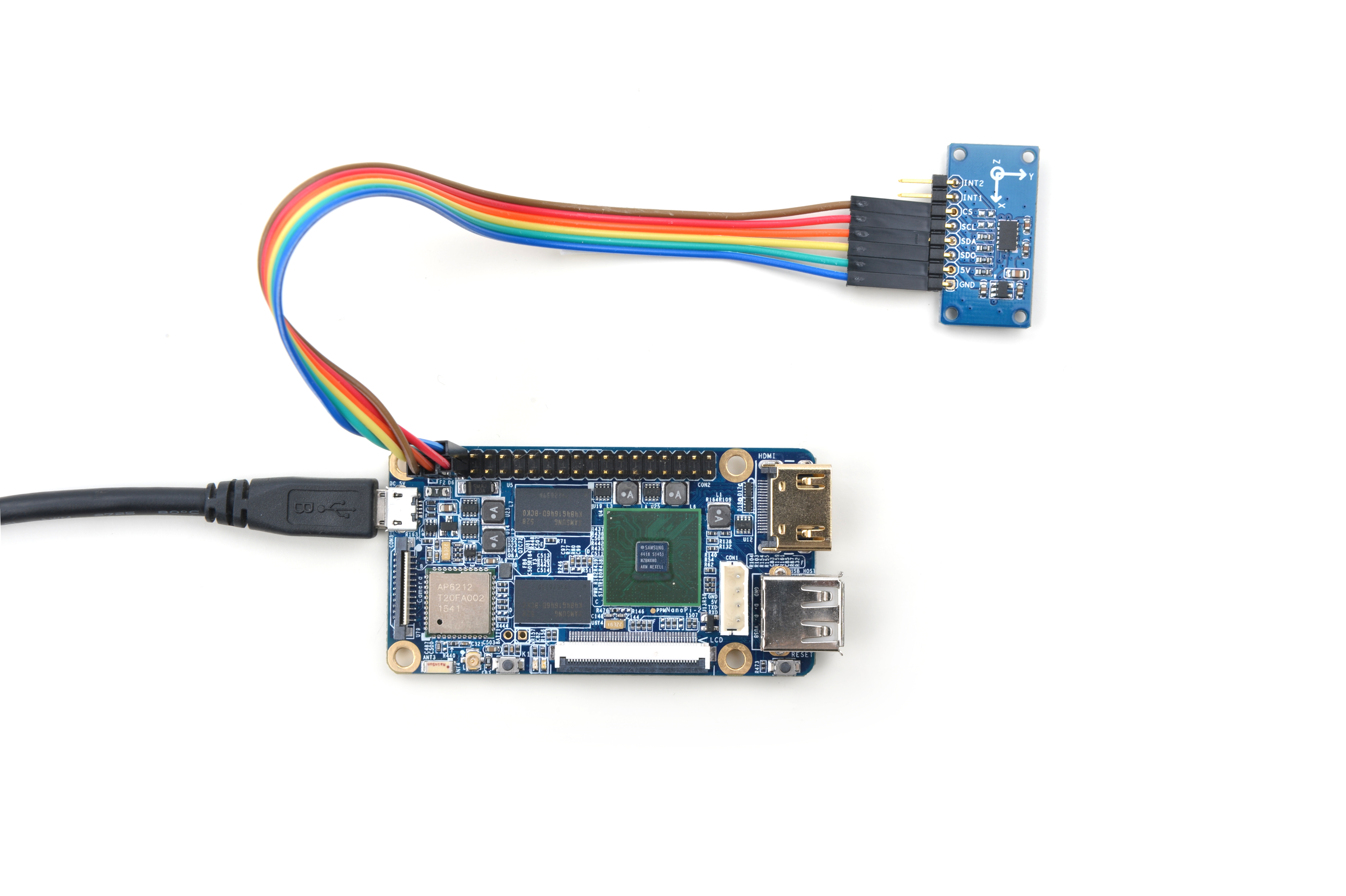
连接说明:
| Matrix-3_Axis_Digital_Accelerometer | NanoPi 2 |
| INT2 | 留空 |
| INT1 | 留空 |
| CS | Pin1 |
| SCL | Pin5 |
| SDA | Pin3 |
| SDO | Pin2 |
| 5V | Pin4 |
| GND | Pin6 |
5.3 编译测试程序
进入Matrix代码仓库,切换到nanopi2分支
$ cd matrix $ git checkout nanopi2
编译Matrix配件代码
$ make CROSS_COMPILE=arm-linux- clean $ make CROSS_COMPILE=arm-linux- $ make CROSS_COMPILE=arm-linux- install
注意:请确保你的主机PC当前使用的交叉编译器为NanoPi 2配套的arm-linux-gcc.4.8.5。
编译成功后库文件位于install/lib目录下,而测试程序则位于install/usr/bin目录下,模块Matrix-3_Axis_Digital_Accelerometer对应的测试程序为matrix-accelerometer。
5.4 运行测试程序
将带有Debian系统的SD卡插入一台运行Linux的电脑,可以挂载SD卡上的boot和rootfs分区。
假设rootfs分区的挂载路径为/media/rootfs,执行以下命令可将Matrix的所有库文件和测试程序拷贝到NanoPi 2的文件系统上。
$ cp install/usr/bin/* /media/rootfs/usr/bin/ $ cp install/lib/* /media/rootfs/lib/ -d
将SD卡重新插入NanoPi 2,上电启动,在Debian的shell终端中执行以下命令运行模块Matrix-3_Axis_Digital_Accelerometer的测试程序。
$ matrix-accelerometer注意:此模块并不支持热插拔,启动系统前需要确保硬件连接正确。
5.5 代码展示
int main(int argc, char ** argv) { char *position = (char *) malloc(32); memset(position, 0, 32); if (adxl34xRead(position) > 0) { printf("Get position: %s", position); } else { printf("Fail to get position\n"); } free(position); return 0; }
6 与NanoPi连接使用
6.1 准备工作
在NanoPi上运行Debian系统,然后在主机PC上安装并使用相应的编译器,参考wiki: NanoPi & How to Build the Compiling Environment。
注意: 只有使用nanopi-v4.1.y-matrix分支编译出来的内核才能配合Matrix配件正常工作。
下载NanoPi内核源代码并编译:
$ git clone https://github.com/friendlyarm/linux-4.x.y.git $ cd linux-4.x.y $ git checkout nanopi-v4.1.y-matrix $ make nanopi_defconfig $ touch .scmversion $ make
编译好后的zImage位于内核源码arch/arm/boot/目录下,把该zImage替换掉NanoPi烧写文件sd-fuse_nanopi/prebuilt下的zImage,重新制作SD卡即可。
6.2 硬件连接
参考下图连接模块Matrix-3_Axis_Digital_Accelerometer和NanoPi:
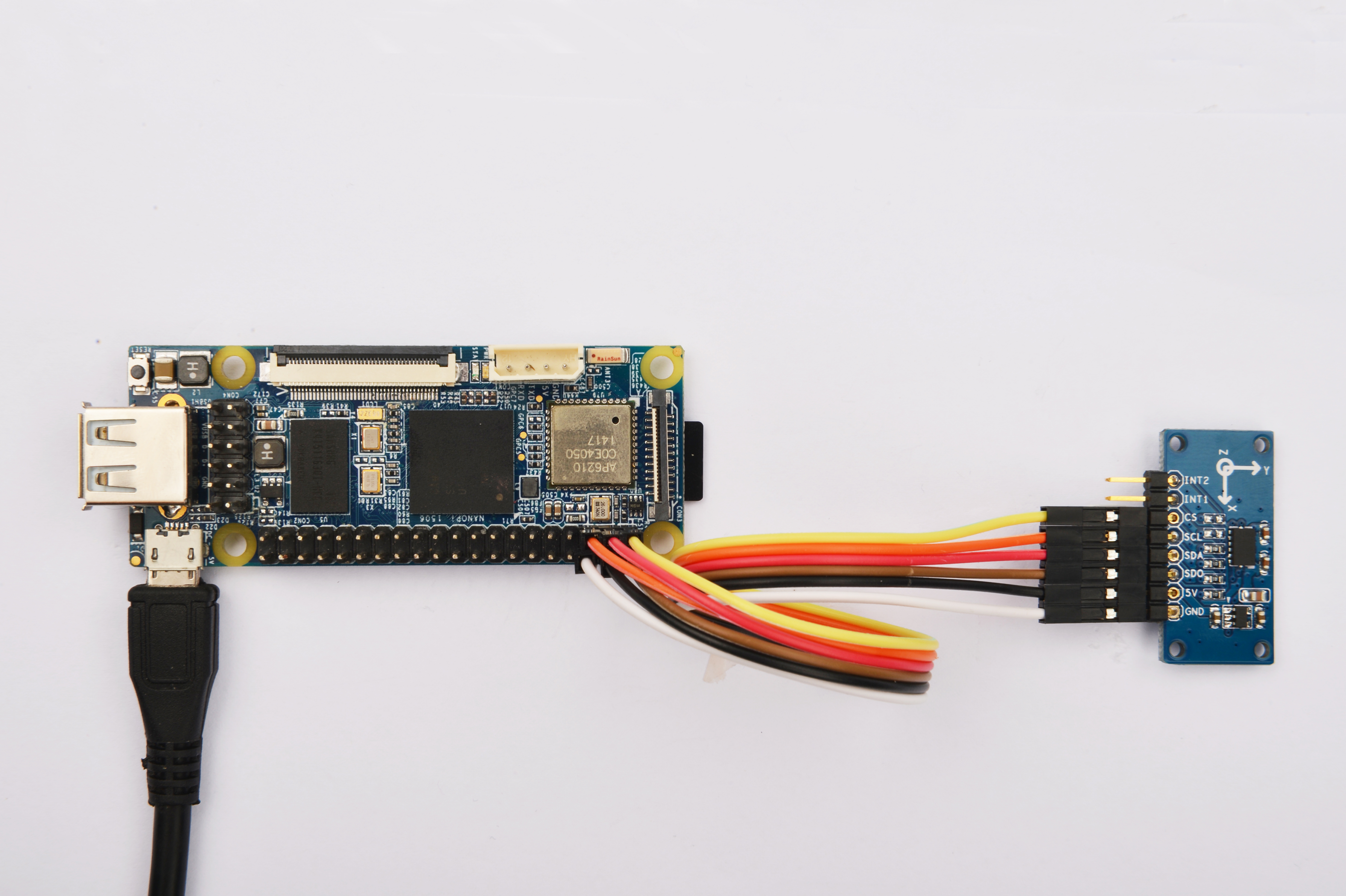
连接说明:
| Matrix-3_Axis_Digital_Accelerometer | NanoPi |
| INT2 | 留空 |
| INT1 | 留空 |
| CS | Pin1 |
| SCL | Pin5 |
| SDA | Pin3 |
| SDO | Pin2 |
| 5V | Pin4 |
| GND | Pin6 |
6.3 编译测试程序
进入Matrix代码仓库,切换到nanopi分支
$ cd matrix $ git checkout nanopi
编译Matrix配件代码
$ make CROSS_COMPILE=arm-linux- clean $ make CROSS_COMPILE=arm-linux- $ make CROSS_COMPILE=arm-linux- install
注意:请确保你的主机PC当前使用的交叉编译器为NanoPi-Debian配套的arm-linux-gcc-4.4.3。
编译出来的库文件位于install/lib目录下,而测试程序则位于install/usr/bin目录下,模块Matrix-3_Axis_Digital_Accelerometer对应的测试程序为matrix-accelerometer。
6.4 运行测试程序
将带有Debian系统的SD卡插入一台运行Linux的电脑,可以挂载SD卡上的boot和rootfs分区。
假设rootfs分区的挂载路径为/media/rootfs,执行以下命令可将Matrix的所有库文件和测试程序拷贝到NanoPi的文件系统上。
$ cp install/usr/bin/* /media/rootfs/usr/bin/ $ cp install/lib/* /media/rootfs/lib/ -d
将SD卡重新插入NanoPi,上电启动,在Debian的shell终端中执行以下命令运行模块Matrix-3_Axis_Digital_Accelerometer的测试程序。
$ matrix-accelerometer注意:此模块并不支持热插拔,启动系统前需要确保硬件正常连接。
6.5 代码展示
int main(int argc, char ** argv) { char *position = (char *) malloc(32); memset(position, 0, 32); if (adxl34xRead(position) > 0) { printf("Get position: %s", position); } else { printf("Fail to get position\n"); } free(position); return 0; }
7 与Tiny4412连接使用
7.1 准备工作
参考Tiny4412光盘里的《友善之臂Ubuntu使用手册》,在Tiny4412上运行UbuntuCore系统,然后在主机PC上安装并使用相应的编译器。
注意:只能使用Tiny4412SDK-1506的底板。
7.2 硬件连接
参考下图连接模块Matrix-3_Axis_Digital_Accelerometer和Tiny4412:
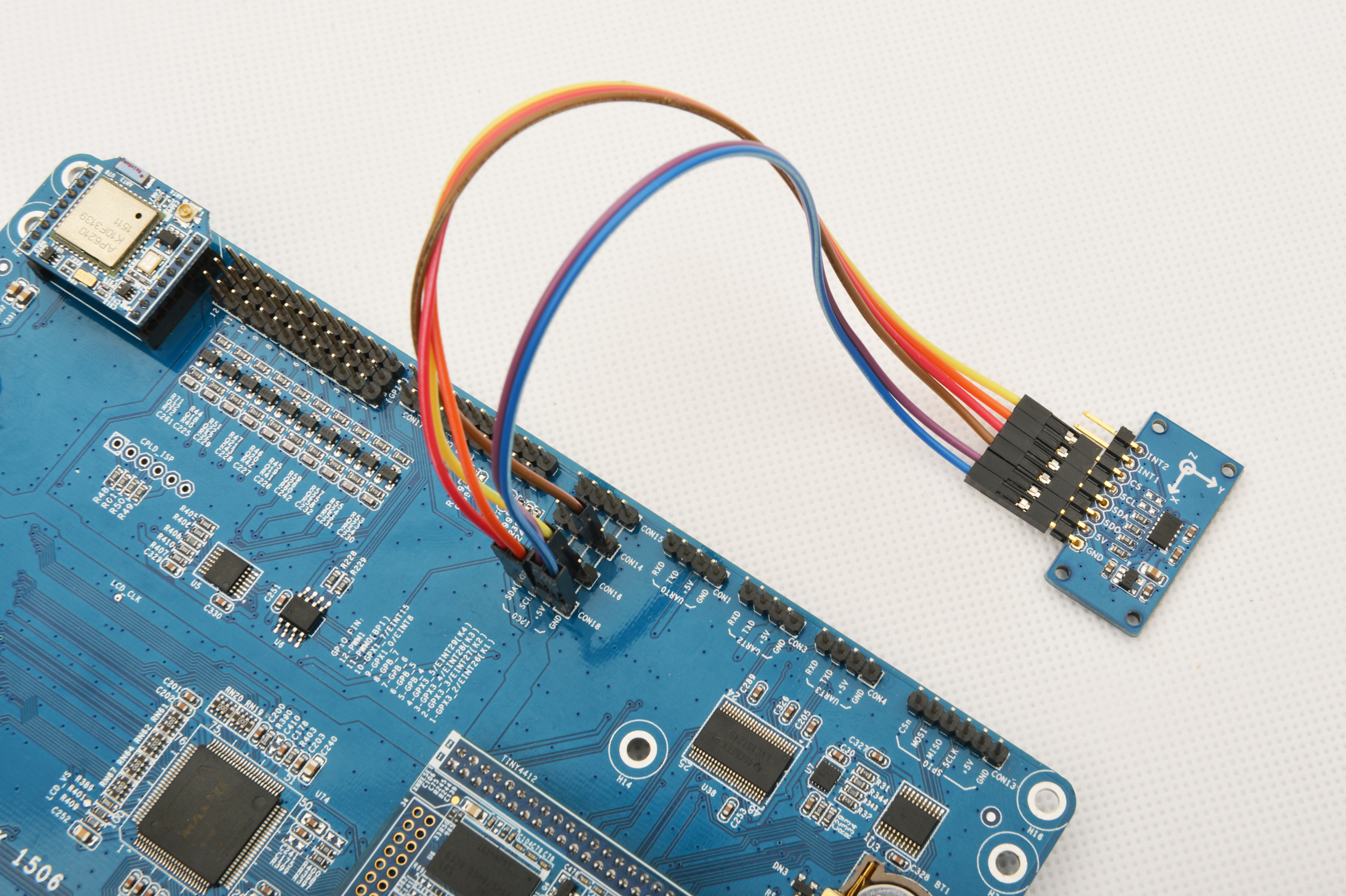
连接说明:
| Matrix-3_Axis_Digital_Accelerometer | Tiny4412 |
| INT2 | 留空 |
| INT1 | 留空 |
| CS | CON16 5V |
| SCL | CON18 SCL |
| SDA | CON18 SDA |
| SDO | CON14 5V |
| 5V | CON18 5V |
| GND | CON18 GND |
7.3 编译测试程序
进入Matrix代码仓库,切换到tiny4412分支
$ cd matrix $ git checkout tiny4412
编译Matrix配件代码
$ make CROSS_COMPILE=arm-linux-gnueabihf- clean $ make CROSS_COMPILE=arm-linux-gnueabihf- $ make CROSS_COMPILE=arm-linux-gnueabihf- install
注意:请确保你的主机PC当前使用的交叉编译器为Tiny4412-UbuntuCore配套的arm-linux-gnueabihf-gcc-4.7.3。
编译出来的库文件位于install/lib目录下,而测试程序则位于install/usr/bin目录下,模块Matrix-3_Axis_Digital_Accelerometer对应的测试程序为matrix-accelerometer。
7.4 运行测试程序
将带有UbuntuCore系统的SD卡插入一台运行Linux的电脑,可以挂载SD卡上的boot和rootfs分区。
假设rootfs分区的挂载路径为/media/rootfs,执行以下命令可将Matrix的所有库文件和测试程序拷贝到Tiny4412的文件系统上。
$ cp install/usr/bin/* /media/rootfs/usr/bin/ $ cp install/lib/* /media/rootfs/lib/ -d
将SD卡重新插入Tiny4412,上电启动,在UbuntuCore的shell终端中执行以下命令运行模块Matrix-3_Axis_Digital_Accelerometer的测试程序。
$ matrix-accelerometer注意:此模块并不支持热插拔,启动系统前需要确保硬件连接正确。
7.5 代码展示
int main(int argc, char ** argv) { char *position = (char *) malloc(32); memset(position, 0, 32); if (adxl34xRead(position) > 0) { printf("Get position: %s", position); } else { printf("Fail to get position\n"); } free(position); return 0; }
